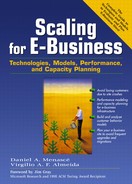2.2. Why Model Customer Behavior?
Figure 2.1 shows the relationship between the customer model, the workload model, and the resource model. This chapter concentrates on the customer model. The other models will be discussed in detail in other chapters of the book.
Figure 2.1. Customer, Workload, and Resource Models.

The customer model captures elements of user behavior in terms of navigational patterns, e-commerce functions used, frequency of access to the various e-commerce functions, and times between access to the various services offered by the site. A customer model can be useful for navigational and workload prediction.
Model User Navigational Patterns for Predictive Purposes. By building models, such as the Customer Behavior Model Graph (CBMG) described in Section 2.4, one can answer what-if questions regarding the effects on user behavior due to site layout changes or content redesign. Such models could potentially be used to predict future moves of a user and pre-fetch objects in order to improve performance.
Capture Workload Parameters. If the only purpose of a customer model is to generate a workload model to be used as input to a re-source model, then it is not necessary to use a detailed model such as the CBMG. Less detailed models, such as the Customer Visit Model (CVM), described in Section 2.8, capture the information needed to build a workload model. The CVM, unlike the CBMG, has no predictive capability to answer what-if questions regarding the impact of customer behavioral changes.
The workload model describes the workload of an e-business site in terms of workload intensity (e.g., transaction arrival rates) and service demands on the various resources (e.g., processors, I/O subsystems, networks) that make up the site. The workload model can be derived from the customer model as we will discuss later in the book.
The resource model represents the various resources of the site and captures the effects of the workload model on these resources. The resource model can be used for predictive purposes to answer what-if questions regarding performance impacts due to changes in configuration, software and hardware architecture, and other parameters. The resource model is used to compute the values of metrics such as response time, throughput, and business-oriented metrics such as revenue throughput (see Section 2.6).
Most of the sections that follow deal with the more detailed Customer Behavior Model Graph as an example of customer model. The Customer Visit Model is introduced in Section 2.8.
